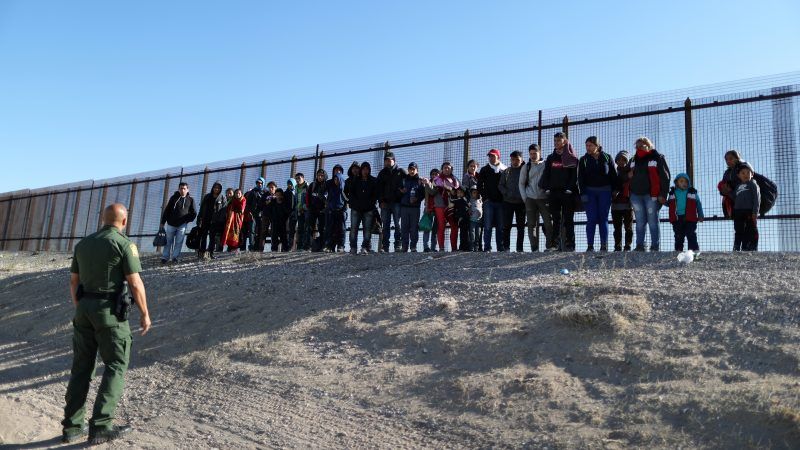Trump Does Not Need Alligators in Moats for a Draconian Anti-Immigration Crackdown—He's Already Outdoing Ike's Harsh 'Operation Wetback'
Trump admires one of the darkest chapters in America's deportation history.

President Donald Trump has denied a New York Times report that he fantasized about building an electrified wall with spikes that "pierce the human flesh" surrounded by a snake- and alligator-filled moat. He is also disputing that he suggested shooting migrants in the legs to slow them down—a part of the story that ABC News separately confirmed. Of course, he is on the record advocating lethal force (not just maiming) against rock-throwing migrants.
He doesn't deny that he wants to get a whole lot tougher on immigration. And he doesn't deny that he fired Homeland Security Secretary Kirstjen Nielsen, who deployed tear gas against the approaching Central American migrants and defended separating children from migrant parents, after she balked at some of his other demands.
At this stage, Trump has already exceeded the harshness even of President Dwight Eisenhower's Operation Wetback, one of the most draconian deportation programs in this country's history—a policy that Trump for years has espoused as a "humane" and successful model.
From 1942 to 1947 the U.S. government barred Texas farmers from using the bracero guest worker program, which allowed farmers elsewhere in the country to legally hire Mexican help. That meant that the Lone Star state faced labor shortages just when its agriculture industry was expanding, thanks to the rise of large-scale farming. Predictably, thousands of Mexican workers started swimming across the Rio Grande to avoid border agents, arriving all wet into the eager arms of Texan farmers. Even after Texas was allowed into the program, the restrictions were still onerous, so there was still an incentive to hire illegally.
This upset the Mexican government, which didn't like losing too many able-bodied Mexican men to better-paying gringos. Meanwhile, American labor unions did not like to see their members' wages undercut by unauthorized Mexicans. And nativists opposed the immigrants just because they were brown. Even some churches and progressive social groups jumped on the enforcement bandwagon, thinking this would rescue the immigrants from exploitative employers. The Teamsters exploited Cold War worries to whip up fears that "more than 100 Communists a day" were flooding the country from the unregulated Mexican border, just like President Trump has been baselessly claiming that terrorists are streaming over America's southern border.
So successful was the campaign to vilify unauthorized immigrants that the University of Chicago's Louis Leal, who was also chairman of the Mexican American Council of Chicago, declared: "One of problems is that of wetbacks coming to Chicago."
Eisenhower was ordinarily a champion of civil rights, and he was actually quite generous to refugees, at least of the white European variety. But facing mounting public pressure, he listened to Border Patrol chief Harlon B. Carter—a convicted murderer—and in 1954 he asked Attorney General Herbert Brownell to ramp up immigration enforcement. The result was Operation Wetback.
Carter had previously tried to deploy the National Guard in rounding up and ejecting immigrants. But it was illegal to use the military to enforce domestic laws—so when Brownell launched Operation Wetback, he instead just appointed a general to run the program using military tactics. Jeeps and planes would swoop in on farms and factories and round up all the brown-skinned folks on the premises, even if they were there legally. Some of them were sent into detention camps pending deportation, just like now. The conditions in these camps were abysmal, and many of the detainees died while being held. In one particularly gruesome incident, 88 Mexicans died of a heat stroke as result of a roundup that occurred while it was 112°. Those who survived were subjected to all kinds of indignities, such as having their heads shaved to make it easier to spot them if they tried to re-enter anytime soon.
Some migrants were airlifted to the Mexican interior. (About three planeloads were flown out of Chicago alone every week.) But as historian Mae M. Ngai has documented, about a quarter were herded into cargo ships—which a later congressional investigation compared to 18th century slave ships and "penal hell ships"—at Port Isabel, Texas, and taken way south in Mexico, so that it would be harder for them to return.
Mercifully, the program was shut down after only a few months. General revulsion at its inhumane tactics sapped support, and Congress refused to renew funding.
Trump and other anti-immigration hardliners sometimes claim that Operation Wetback solved the illegal immigration problem by deporting over 1.3 million Mexicans and putting the fear of God in future illegal migrants. But actually what solved the problem wasn't Ike's crackdown—it's the fact that he reformed and expanded the bracero program, allowing migrants to legally enter the country. President Lyndon Johnson ended that program about a decade later, once again sowing the seeds for unauthorized immigration whose fruits we are witnessing today.
Eisenhower created so much havoc over a few months with only 1,000 border patrol agents. Trump has close to 20,000 agents, about 16,000 on the southern border. He does not need alligators in moats to outdo even the damage done by Operation Wetback.
Show Comments (123)